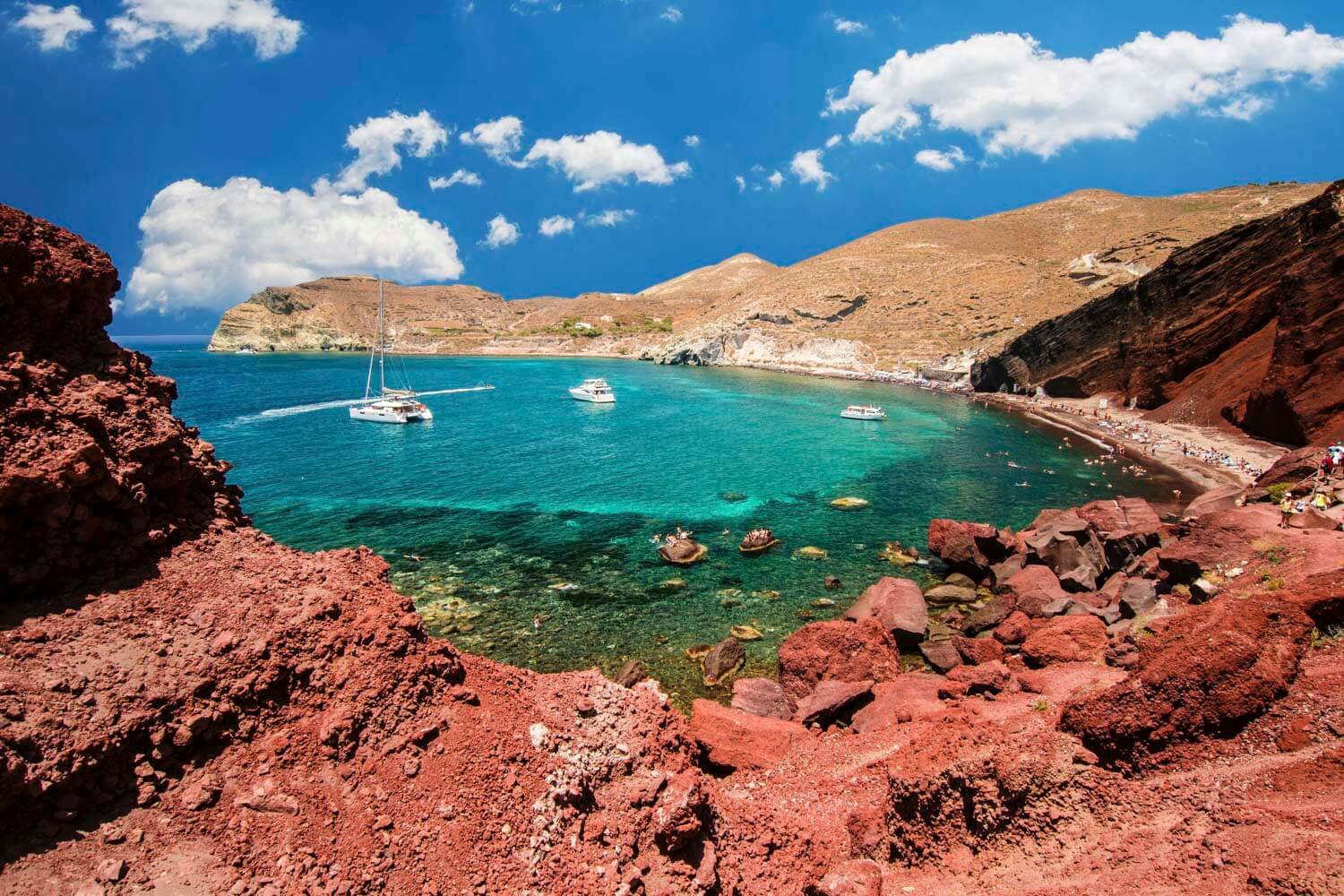Greece is one of the most visited destinations in Europe and the World. It’s steeped in a rich and interesting history. It enjoys fine weather and sunshine for the large majority of the year. And it has the longest coastline in Europe, with islands scattered across its Seas. With this winning combination, when is the best time to visit Greece?
What the weather is like, how big the crowds are and what the costs of travelling are the big factors to consider. Whether you’re planning on ascending the Acropolis, or just planning to conquer the sun lounger, here is a run through of the best time to visit Greece.
Table of Contents
High and low season in Greece
The holiday season in Greece runs from mid-April to late October. Spring is relatively short and the summer heat takes over quickly. Temperatures begin to increase rapidly from April, before peaking in July and August. It then remains warm through the months of September and into October.
The high season in Greece and the Greek islands is considered to be June through September. The shoulder seasons are April and May, when temperatures are hotting up, and October, when things are cooling down. The low season is November through to March, great for exploring the cities, but the islands are pretty much shut.
Weather
Greece is one of the hottest countries in Europe. The summers are invariably hot and dry whilst the winters are mild and rainy. The Mediterranean climate makes it a stand out destination for tourists looking for a sunny escape. Fine weather is pretty much guaranteed, perfect for spending time outdoors. Seeing the sites, exploring ancient acropolises and swimming in the sea all make Greece a great place to visit particularly during warm weather.
Average temperatures from May through to October are over 20°C. Hence the long holiday season and when most tourist infrastructure on the Greek islands is open and in full swing.
The months of July and August are when temperatures are at their absolute highest. Expect average daily temperatures of 29°C and average highs of 34°C. The relentless sun can make exploring and spending long periods without shade difficult. So make sure you slap on the sun cream, especially between the hours of 1pm and 4pm.

Seek some respite from the high heat and visit in late May, early June and late September. Often said to be the best time to visit Greece and the Greek islands. The sun will be less intense, temperatures during the day and evening are pleasant and swimming/outdoor activities are still enjoyable.
The short spring and autumn means wrapping up, particularly in the evenings. And the low winter season, although thoroughly enjoyable, sees temperatures reach average lows of 7°C and at times below freezing.
How hot is Greece?
Being the capital city, Athens has noticeably the highest temperatures in Greece over the summer. Shown below are the daily averages and highs and lows.
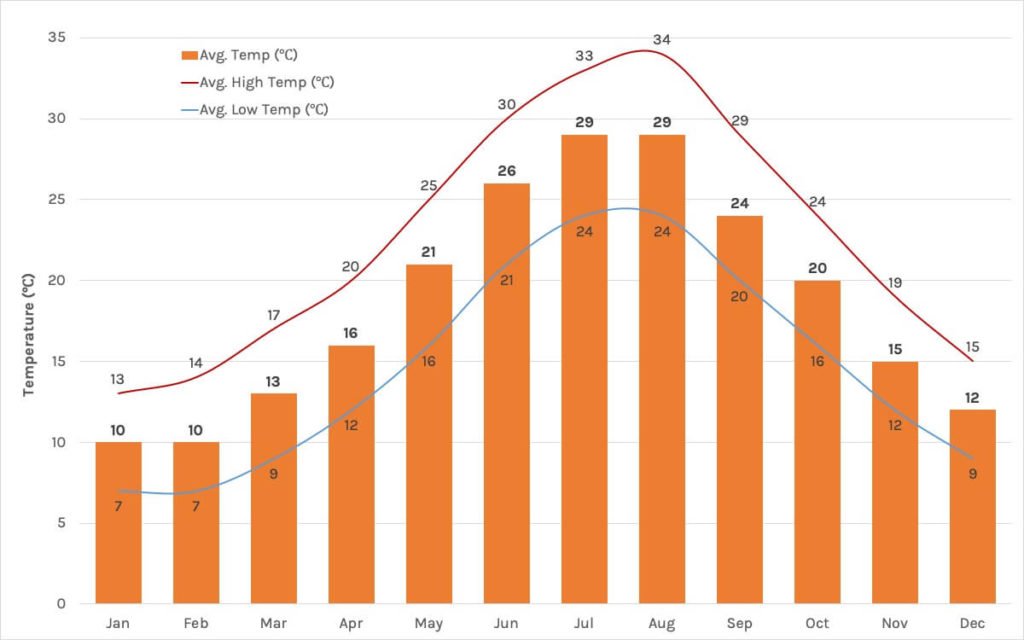
There are slight variations in temperature between the different parts of Greece. The average high temperatures are highest in the cities, such as Athens and Thessaloniki. The Sporades, east coast of Evia and the Cyclades are kept slightly cooler by the Meltemi winds that blow across the Aegean. Whilst the Dodecanese and Ionian islands are some of the hottest in July and August. Rhodes is the hottest Greek island in October and great to visit for some late summer sun.
Take a look here for an introduction to the Greek island groups and their different characteristics.
Average temperatures
| Month | Crete | Santorini | Rhodes | Athens | Zakynthos | Peloponnese | Thessaloniki |
|---|---|---|---|---|---|---|---|
| Jan | 11 | 12 | 12 | 11 | 11 | 11 | 6 |
| Feb | 12 | 12 | 12 | 11 | 11 | 11 | 6 |
| Mar | 13 | 14 | 14 | 13 | 13 | 12 | 10 |
| Apr | 17 | 16 | 17 | 15 | 15 | 15 | 14 |
| May | 21 | 20 | 20 | 19 | 19 | 18 | 18 |
| Jun | 24 | 24 | 24 | 23 | 23 | 23 | 23 |
| Jul | 26 | 26 | 26 | 26 | 26 | 25 | 25 |
| Aug | 26 | 26 | 26 | 26 | 26 | 25 | 25 |
| Sep | 24 | 24 | 24 | 24 | 24 | 23 | 21 |
| Oct | 20 | 21 | 21 | 20 | 20 | 19 | 16 |
| Nov | 17 | 17 | 16 | 16 | 16 | 15 | 11 |
| Dec | 14 | 13 | 14 | 13 | 13 | 12 | 7 |
High temperatures
| Month | Crete | Santorini | Rhodes | Athens | Zakynthos | Peloponnese | Thessaloniki |
|---|---|---|---|---|---|---|---|
| Jan | 16 | 14 | 15 | 13 | 14 | 15 | 9 |
| Feb | 16 | 14 | 15 | 14 | 14 | 16 | 10 |
| Mar | 17 | 16 | 17 | 17 | 16 | 17 | 14 |
| Apr | 20 | 18 | 20 | 20 | 19 | 20 | 19 |
| May | 24 | 23 | 23 | 25 | 23 | 24 | 24 |
| Jun | 28 | 27 | 27 | 30 | 28 | 29 | 29 |
| Jul | 29 | 29 | 29 | 33 | 31 | 31 | 31 |
| Aug | 29 | 29 | 29 | 34 | 31 | 31 | 30 |
| Sep | 27 | 26 | 27 | 29 | 28 | 29 | 27 |
| Oct | 24 | 23 | 24 | 24 | 23 | 25 | 21 |
| Nov | 21 | 19 | 19 | 19 | 19 | 20 | 14 |
| Dec | 17 | 15 | 16 | 15 | 16 | 17 | 10 |
How warm is the sea?
Sea temperatures are highest from July through to September, reaching 25°C in August, the perfect temperature for cooling down during those hot afternoons. If swimming and sunbathing is your top priority then July and August would be the best time to visit Greece, particularly the Greek islands.
June and October are still great to swim and it can be surprising how great the weather still is in October.
The sea in April and May is still warming up, although the sun is out for longer. There is a trade off between swimming and longer days when choosing to visit during the shoulder seasons.
Sea temperatures are practically the same across Greece – the Aegean and Ionian seas have, at most, a one degree difference during the months between May and October.
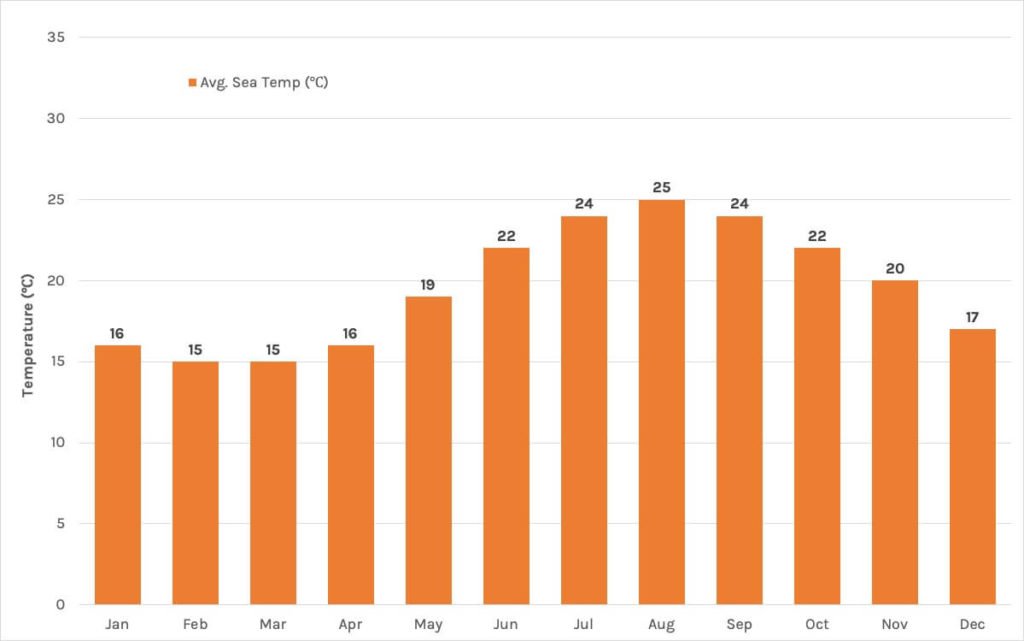
The best time to visit Greece for sun
Greece receives around 300 days and nearly 3,000 hours of sunshine a year. So as well as the high temperatures, expect uninterrupted clear blue skies on your summer holidays. The sun is out on average twelve hours a day June to September.
In October, the weather is generally still sunny and clear, still a great time to visit, but there are the odd few rainy days whilst the days are getting shorter. The same can be said about Spring as the days get longer.
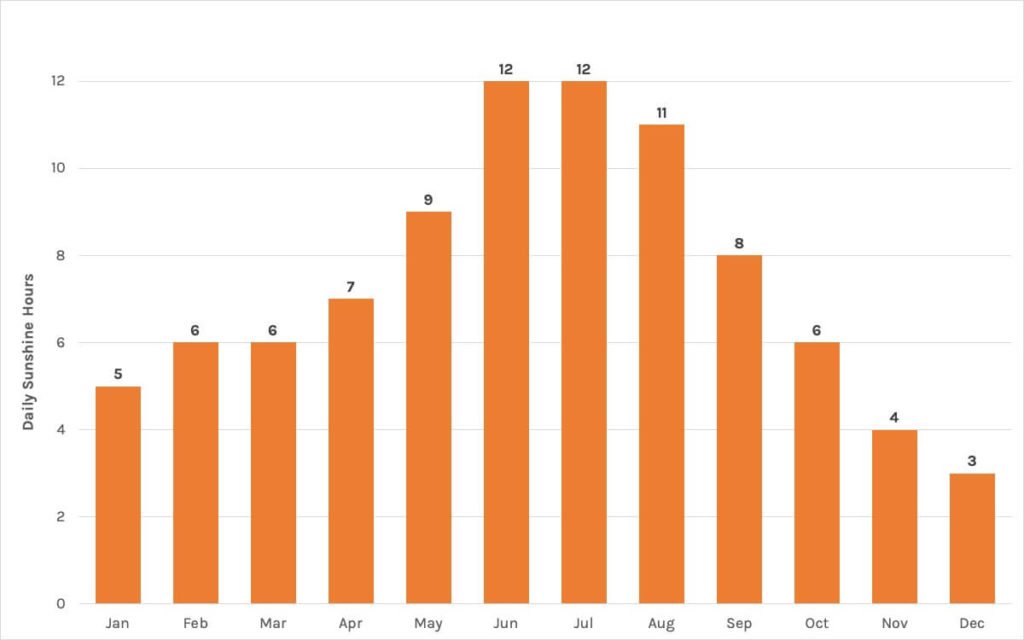
Wind
Mainland Greece is not particularly windy, whilst the islands generally are. Some islands are windier than others and you may have heard about or experienced the Meltemi winds before. These winds blow from north to south in the Aegean Sea. Therefore you will only need to watch out for them if you plan to holiday in the Cyclades and parts of the Sporades and east coast of Evia. They are usually prevalent during the day, strongest from June through to September, and can blow for days at a time.
The islands of Mykonos, Naxos, and Santorini are affected the most. And, although annoying, they do keep temperatures slightly cooler, particularly in the summer when they are most prevalent. Furthermore, they are the reason why visibility is always good and why heat waves are non existent in the Aegean.
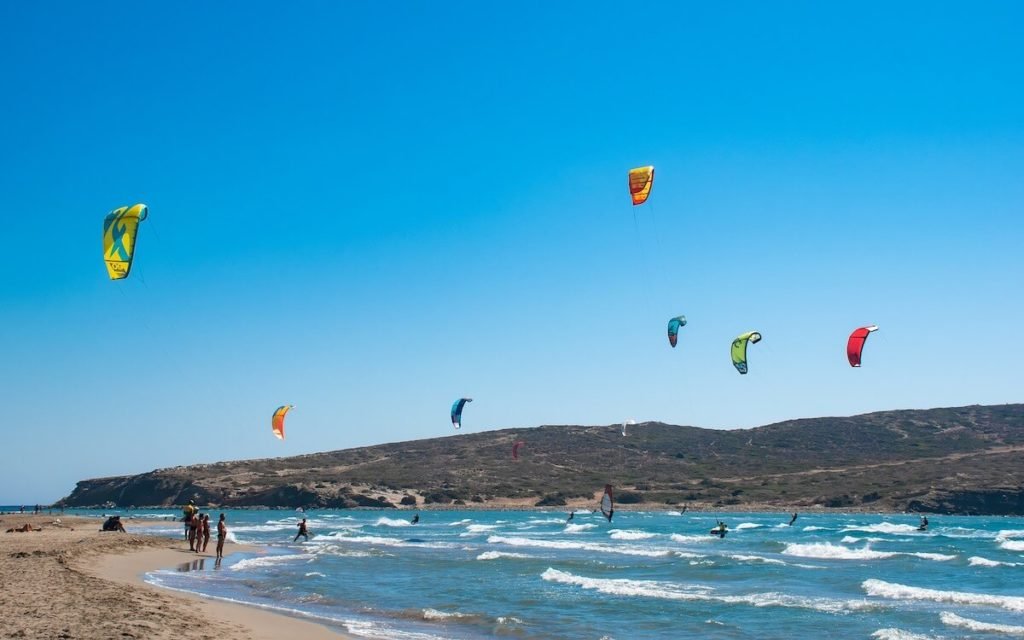
There is no guarantee you can escape the Meltemi winds at any time. It comes down to a bit of luck. Mykonos, commonly referred to as the island of the winds, is still spectacular when the winds blow. Try visiting Mykonos in May or June for the lowest chance of strong winds.
When does it rain in Greece?
There is practically no rain during the summer months in Greece. And if you are unlucky enough to get rain, it passes relatively quickly.
From November through to February is when it rains the most in Greece, particularly December and January. Rainfall during these months can be quite heavy. Comparatively, Greece might get more total rain during this period than the likes of the UK, Germany and France but it will have much fewer rainy days.
Rainfall and rainy days in Athens
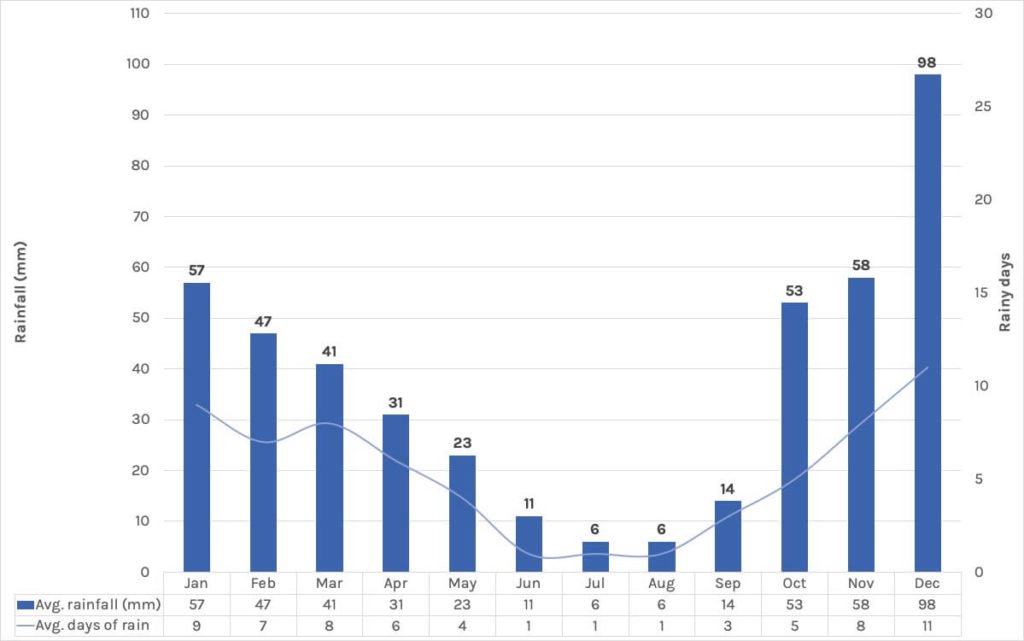
Rainfall in Greece and the Greek islands
The Ionian islands and the Peloponnese get more rain during the Autumn and Winter. It’s the reason for their characteristic lush green landscapes. Athens and island groups such as Crete and, in particular, the Cyclades have the least rainfall. Their arid landscapes owing to the lack of rain, driven in part by the northerly Meltemi winds and their geography.
| Month | Athens | Santorini | Rhodes | Zakynthos | Skiathos | Crete | Peloponnese |
|---|---|---|---|---|---|---|---|
| Jan | 57 | 71 | 135 | 150 | 82 | 78 | 113 |
| Feb | 47 | 43 | 102 | 113 | 70 | 64 | 102 |
| Mar | 41 | 40 | 81 | 90 | 59 | 62 | 73 |
| Apr | 31 | 16 | 35 | 51 | 38 | 21 | 48 |
| May | 23 | 11 | 9 | 17 | 39 | 11 | 23 |
| Jun | 11 | 20 | 0 | 7 | 26 | 1 | 7 |
| Jul | 6 | 7 | 0 | 5 | 22 | 1 | 4 |
| Aug | 6 | 0 | 0 | 9 | 26 | 1 | 10 |
| Sep | 14 | 11 | 5 | 25 | 38 | 10 | 28 |
| Oct | 53 | 38 | 68 | 147 | 71 | 40 | 100 |
| Nov | 58 | 59 | 105 | 159 | 65 | 69 | 142 |
| Dec | 98 | 75 | 141 | 170 | 95 | 89 | 154 |
Crowds
Greece welcomes 33 millions tourists every year. A number that has been rising for the last few decades and making it one of the most popular destinations in the world. Tourism is easily one of the country’s most important sectors.
You can smartly dodge the mass of tourists by avoiding July and August – the busiest time of year. If you’re looking for a summer holiday – spending time outdoors and at the beach – then remember that the summer in Greece can be considered longer than other countries. Choosing to travel during the shoulder seasons in the months of April, May, September and October is genuinely a great time to visit Greece.
One exception to the rule is the national public holiday on 15th August. Assumption day, celebrating the Virgin Mary sees many people abandon the cities and spend a week at their summer retreats. Hence, during this week, Athens and Thessaloniki become conveniently calm, whilst the seasides and Greek islands see a spike of local tourists.
In April and May, the days are warm and long though the sea is still cold. These are excellent months to go sightseeing and to spend the days and evenings exploring. In late September and October, the weather is still surprisingly good, the sea warm, and often the best time to visit the Greek islands.
Costs
July and August time brings about the highest demand for flights and hotels. Plan your trip either side of these months and you can save yourself a bit of cash. That said, Greece isn’t a particularly expensive country to live or visit. Everyday expenses such as food, transport and attractions are very fair and will not change whenever you decide to go.
Greece has many expats living and working abroad and so expect more expensive flights in the summer, over Christmas and during Easter. Flights from the UK often exceed £300 if booking around these times and with short notice.
Visit before June and after mid-September and you will find cheaper flights and accommodation. Go during the low season and prices are better still. The Greek islands wont be an option but Athens and Thessaloniki are great cities to visit during November onwards.
Typical savings on flights and hotels, the biggest expenses you’ll incur, are set out below. Use this as a rough guide if you are planning to visit Greece on a budget. Use price comparison websites and book as early as possible.
When to visit Greece?
Best time to visit the Greek islands
The Greek islands can be visited from April through to October. They begin to open to tourism from mid-April. Most hotels, restaurants, beach bars and shops are open by mid-May in all but the quietest islands. They begin to gradually roll down their shutters again from late September and by the end of October the islands are all but shut. Go in the midst of August and September for a great Greek island hopping vacation.
Sea temperatures in Greece and the Greek islands are around 25°C July through September. However, in late May, June, September and early October, swimming is still more than pleasant. It is, in general, a great time to visit the Greek islands. There are no crowds, hotels and flights are much cheaper and the beaches and towns are less crowded making it an altogether different experience.
Weather begins to be a little less predictable going into October compared to the continuous blue skies of summer. However, you’re still sure to get a fair share of sunshine and warm days. Many people are surprised at how fine the weather is at this time of year.

Best time to visit Greece for a city break
The two overwhelmingly popular options for a city break in Greece are Athens and Thessaloniki. Unlike the islands, they remain vibrant throughout the year. Whether ascending the Parthenon or strolling Thessaloniki’s waterfront, doing so in the searing mediterranean sun is far from ideal. So avoid the peak summer months and seek respite from the sun as well as the hordes of tourists. The exception to this rule, if you can handle the heat, is planning your visit when the locals flee en masse, in the week coinciding with the public holiday on 15th August.
Both cities are great to visit year round. Go from March to May, whilst the days are getting longer and the weather is turning dryer. Visit Thessaloniki and Athens in October and November – the nights might draw in quicker, but the tourists are mostly gone yet the city is still full of life.
Best time to visit Greece to go sightseeing
Greece has an abundance of interesting sights, from museums and UNESCO world heritage sites to outdoor theatres and bustling markets.
Avoid the long queues and rubbing shoulder to shoulder with eager tourists. Plan your visit April to May and September to October to make the most of your days spent on holiday. Strolling around the towns, cities and archaeological sites will be much more relaxed. Outdoor performances such as those at the Odeon of Herodes Atticus will still be in full swing.

Best time to visit Greece for nightlife
The city’s restaurants, bars and clubs are lively year round. Thessaloniki regularly pops up as one of the best European cities to visit and was voted European youth capital in 2014. Literally visit anytime March to November. The city is walkable and the districts of Ladadika, Valaoritou and Sygrou buzz with excitement getting livelier and busier through the night, particularly in summer.
Mykonos, Paros and Ios are the party islands of Greece. For the most epic beach parties, packed out bars and clubs, head there in the peak of summer in July and August.
For those who can live with a little less excitement, nightlife on the Greek islands is still great as early as late May and up to late September.

